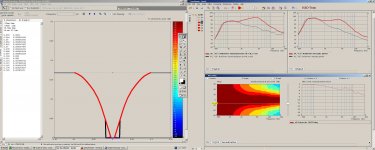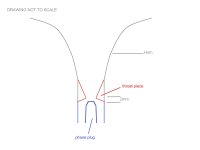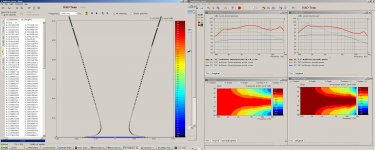Hi All,
At the moment I'm experimenting with a axisymetric horn on a coax driver, which is an off the shelf device. The device is quite loud (it's intended for PA use), but is way too harsh to me to be usable.
I've dismantled the device to check on the design (see attached picture) And I've found one thing which could certainly be the cause of some problems. The throat of the horn has a quite large (38mm wide, 45mm height) piece which is almost straight, this is the part which goes through the magnet of the LF driver. Then the real horn starts with a quite abrupt bent, all possible HOM generators.
My idea was to create (having it tooled from aluminium) a throatpiece which turns the original throat (black line) into the modified throat (red line), basically narrowing the throat entrance so it can expand to the horn flare.
I have run some BEM simulations on this, as seen in the picture, and the results look quite promising, smoother FR, smoother off axis response and even higher output.
My question is: before I get the piece tooled, which will obviously cost some money, I would like to know if I am really missing something here and if it, for some reason is a very bad idea to do this. (compression, distortion, heat, diafragma destruction etc.)
many thanks in advance,
Kees
At the moment I'm experimenting with a axisymetric horn on a coax driver, which is an off the shelf device. The device is quite loud (it's intended for PA use), but is way too harsh to me to be usable.
I've dismantled the device to check on the design (see attached picture) And I've found one thing which could certainly be the cause of some problems. The throat of the horn has a quite large (38mm wide, 45mm height) piece which is almost straight, this is the part which goes through the magnet of the LF driver. Then the real horn starts with a quite abrupt bent, all possible HOM generators.
My idea was to create (having it tooled from aluminium) a throatpiece which turns the original throat (black line) into the modified throat (red line), basically narrowing the throat entrance so it can expand to the horn flare.
I have run some BEM simulations on this, as seen in the picture, and the results look quite promising, smoother FR, smoother off axis response and even higher output.
My question is: before I get the piece tooled, which will obviously cost some money, I would like to know if I am really missing something here and if it, for some reason is a very bad idea to do this. (compression, distortion, heat, diafragma destruction etc.)
many thanks in advance,
Kees
Attachments
Actually, the phase plug looks pretty complex (the HF is a coax driver itself), so I really wouldn't know what it exactly does and how to model this. The simulations I've made now are based on the assumption that there is a plane wave at the exit of the HF driver (the blue line in the picture).
By trial and error I have found that the current "throat plug" design gives the best results. This means that the center hole of the throatplug rises 2mm from the sides. I am aware of the fact that the very sharp corner which follows can create HOM etc. but when I simulate a rounder corner the results are worse.
Any thought about the extra compression factor? would this be bad or good?
By trial and error I have found that the current "throat plug" design gives the best results. This means that the center hole of the throatplug rises 2mm from the sides. I am aware of the fact that the very sharp corner which follows can create HOM etc. but when I simulate a rounder corner the results are worse.
Any thought about the extra compression factor? would this be bad or good?
Smaller throat = higher LF, HF corner, ergo its entire gain BW is shifted higher and the higher compression will roll off its extreme HF, so the net increase is a a bit flatter, narrower BW. The trade-off is a less damped system with a higher tuning impedance and increased excursion, so now you ideally need to decrease its rear chamber Vb since this once straight pipe was part (all?) of the HF filter chamber Vb, so the net increase is ~the same Fr, HF response except with a higher F3, Fc, requiring XO adjustment and maybe it no longer matching well to the woofer section.
Then there's the issue of how these changes will affect the phase plug's performance which IME can include the apertures closing up due to high acoustic resistance, rolling off its LF, so my 'knee-jerk' response is this mod will cause more potential problems than it solves and may cause premature diaphragm failure in a prosound app. For a HIFI app, a foam insert/tweaking the XO is a much better solution IME.
Only one way to know for sure though.
GM
Then there's the issue of how these changes will affect the phase plug's performance which IME can include the apertures closing up due to high acoustic resistance, rolling off its LF, so my 'knee-jerk' response is this mod will cause more potential problems than it solves and may cause premature diaphragm failure in a prosound app. For a HIFI app, a foam insert/tweaking the XO is a much better solution IME.
Only one way to know for sure though.
GM
Ahhh... a BMS unit. I see what you are saying.
What I am wondering is what the distance between the rear of the horn and the phase plug?
Do you have a jpeg of the disassembled unit?
You might find that a flat rear to the piece that you are making is not correct, depending on the geometry of the exit of phase plug...
But, if it ends up making that HF response flatter, then it is all good!
_-_-bear
What I am wondering is what the distance between the rear of the horn and the phase plug?
Do you have a jpeg of the disassembled unit?
You might find that a flat rear to the piece that you are making is not correct, depending on the geometry of the exit of phase plug...
But, if it ends up making that HF response flatter, then it is all good!
_-_-bear
See the attached picture for a schematic drawing. The "throatpiece" won't be flat at the bottom, but will rise 2mm to the centre. This is empirically based on the BEM simulations I've run.
I've also did ALOT of measurements with different sorts of felt/wool/30ppi reticulated foam (Geddes) at several locations all around the horn. My initial goal was to open up the angle at >8kHz with the foam , because I read some old patent (not Geddes) about doing this. I actually could measure delay differences with/without foam inserted, and I wanted to delay more to the outside of the horn. that didn't work (now I understand why, the gain effects counteract the delay effect).
What I did find was that the horn sounded much smoother with the foam (30ppi), but I lost way to much gain in th HF (10dB @ 10kHz). Later on I read a post from Geddes saying that the more HOM a horn has, the more you loose at the HF, so I guess this one is pretty bad...
In the end the hornshape is just not very good, but I like the coax concept with the 12". So when this thoatpiece will work out fine, I will design a complete new horn for the driver combination and have it tooled from aluminium. (yeah probably expensive, but R&D just will cost money...)
I've also did ALOT of measurements with different sorts of felt/wool/30ppi reticulated foam (Geddes) at several locations all around the horn. My initial goal was to open up the angle at >8kHz with the foam , because I read some old patent (not Geddes) about doing this. I actually could measure delay differences with/without foam inserted, and I wanted to delay more to the outside of the horn. that didn't work (now I understand why, the gain effects counteract the delay effect).
What I did find was that the horn sounded much smoother with the foam (30ppi), but I lost way to much gain in th HF (10dB @ 10kHz). Later on I read a post from Geddes saying that the more HOM a horn has, the more you loose at the HF, so I guess this one is pretty bad...
In the end the hornshape is just not very good, but I like the coax concept with the 12". So when this thoatpiece will work out fine, I will design a complete new horn for the driver combination and have it tooled from aluminium. (yeah probably expensive, but R&D just will cost money...)
Attachments
Kessito,
The throat piece as you have shown is likely to introduce substantial diffraction artifacts. I don't know what the actual geometry in there is, but the key is to make extremely smooth and clean transitions, and to have zero discontinuities in slope of the walls of the horn... of course maybe the drawing is just very crude and the actual piece will be ok. No way to know from here.
I don't exactly buy the explanation the Geddes applies here, but who knows, he is a PhD and I am not.
The throat piece as you have shown is likely to introduce substantial diffraction artifacts. I don't know what the actual geometry in there is, but the key is to make extremely smooth and clean transitions, and to have zero discontinuities in slope of the walls of the horn... of course maybe the drawing is just very crude and the actual piece will be ok. No way to know from here.
I don't exactly buy the explanation the Geddes applies here, but who knows, he is a PhD and I am not.
Please see the picture attached. I created the curve for the throatpiece with a 5th order bezier curve, giving me the possibillity to exactly match the horn angle and the dimensions.
If you look at the graph's, axidriver predicts that the horn with the throatpiece (red curve) will have more output above +-1,2kHz than the horn without the throatpiece (green curve). Below 1,2kHz the output suffers, which is fine because I'll be crossing it at 1,3kHz.
If you look at the graph's, axidriver predicts that the horn with the throatpiece (red curve) will have more output above +-1,2kHz than the horn without the throatpiece (green curve). Below 1,2kHz the output suffers, which is fine because I'll be crossing it at 1,3kHz.
Attachments
- Status
- This old topic is closed. If you want to reopen this topic, contact a moderator using the "Report Post" button.
- Home
- Loudspeakers
- Multi-Way
- Need advice on horn throat modification


